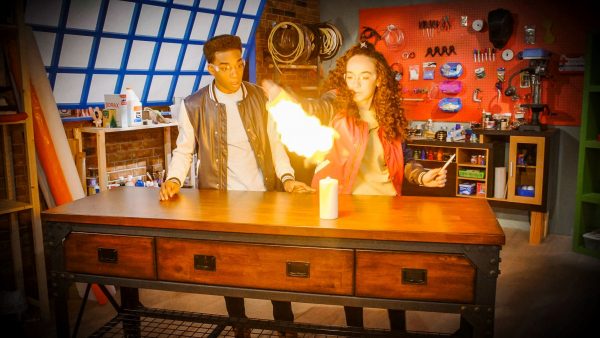Gas Definition
A gas is a form of matter that can be invisible. For example, boiling water turns into water vapor, a gas.
View Lesson on Conservation of Matter
Become a member to get full access to our entire library of learning videos, reading material, quiz games, simple DIY activities & more.
Become a member to get full access to our entire library of learning videos, quiz games, & more.
Plans & Pricingto watch this full video.

Access All Videos
and Lessons, No Limits.
Access All Videos

No credit card required,
takes 7 sec to signup.
No card required

Ready-to-go lessons
that save you time.
Ready-to-go lessons
If you are on a school computer or network, ask your tech person to whitelist these URLs:
*.wistia.com, fast.wistia.com, fast.wistia.net, embedwistia-a.akamaihd.net
Sometimes a simple refresh solves this issue. If you need further help, contact us.
Conservation of Matter
Fun Facts
- Dry ice turns from solid to gas without becoming liquid first.
- Burning sugar and baking soda releases gases, forming an expanded 'snake'.
- Burning candle wax changes into carbon dioxide and water vapor gases.
Why Do We Need To Know About Gas
Learning how water changes from liquid to gas helps us understand evaporation. This is very important for cleaning water to make it pure. This process is key for creating energy to power things.
Knowing about gas and what it can do can lead to different jobs. On food making, evaporation makes tastes stronger. In studying the environment, scientists focus on how carbon moves around. These examples show how gas is very useful in everyday life and in business around the world.
Frequently Asked Questions
Check out the Full Lesson on Conservation of Matter
In this lesson, we learn that:
- The amount of matter is conserved when a substance changes form.
- When a substance dissolves it doesn’t vanish, it simply changes form.
- When something burns up it turns into gases that you can’t see.
Related Topics
- Biodiversity Definition
- Climate Definition
- Competition Definition
- Compound Definition
- Conservation Definition
- Definition Of Evidence
- Definition Of Experiment
- Definition Of Living Things
- Divergent Boundary Definition
- Endoskeleton Definition
- Fertilizer Definition
- Food Web Definition
- Friction Definition
- Gas Definition
- Group Behavior Definition
- Humidity Definition
- Internal Structures Definition
- Invasive Species Definition
- Landslide Definition
- Law Of Conservation Of Matter Definition
- Lever Definition
- Light Definition
- Limited Resource Definition
- Liquid Nitrogen Definition
- Metamorphosis Definition
- Moon Definition
- Natural Resource Definition
- Non-renewable Energy Definition
- Paleontologist Definition
- Parasitism Definition
- Pattern Definition
- Pollen Definition
- Pollination Definition
- Predation Definition
- Push Definition
- Rain Definition
- Rain Gauge Definition
- Reflecting Surface Definition
- Renewable Energy Definition
- Rock Definition
- Sedimentary Rock Definition
- Solution Definition
- Sunlight Definition
- Temperature Definition
- Texture Definition
- Transform Boundary Definition
- Volcano Definition
- Weight Definition
Start a Free Trial Today. Get a $5 Amazon Gift Card!
Teachers! Start a free trial & we'll send your gift card within 1 day. Only cards left. Try it now.
Select Grade
Select Subject
This email is associated with a Science Kit subscription. Kit subscriptions are managed on this separate page: Manage Subscription

-
Download InvoiceScience & Math$/yr
-
Download InvoiceScience Only$/yr

access all lessons
• No credit card required •
"My students loved the videos. I started the video subscription in May and used them as a review before the state test, which I know contributed to 100% of my class passing the state test."
Rhonda Fox 4th Grade Teacher, Ocala, Florida
Use Generation Genius in Your School
Access all lessons free for 30 days.
"My students loved the videos. I started the video subscription in May and used them as a review before the state test, which I know contributed to 100% of my class passing the state test."
Rhonda Fox 4th Grade Teacher, Ocala, Florida
• No credit card required •
Already a member? Sign In
* no credit card required *

* no credit card required *
* no credit card required *


to Discover the Benefits of Generation Genius
Learn How to Save for Your School & District!

no credit card required
Skip, I will use a 3 day free trial
Enjoy your free 30 days trial
-
Unlimited access to our full library
of videos & lessons for grades K-5. -
You won’t be billed unless you keep your
account open past your 14-day free trial. -
You can cancel anytime in 1 click on the
manage account page or by emailing us.
-
Unlimited access to our full library of videos & lessons for grades K-5.
-
You won't be billed unless you keep your account open past 14 days.
-
You can cancel anytime in 1-click on the manage account page.
Cancel anytime in 1-click on the manage account page before the trial ends and you won't be charged.
Otherwise you will pay just $10 CAD/month for the service as long as your account is open.
Cancel anytime on the manage account page in 1-click and you won't be charged.
Otherwise you will pay $10 CAD/month for the service as long as your account is open.
We just sent you a confirmation email. Enjoy!
DoneWe use cookies to make your experience with this site better. By using this site you agree to our use of cookies. Click "Decline" to delete and block any non-essential cookies for this site on this specific property, device, and browser. Please read our privacy policy for more information on the cookies we use.Learn More
We use cookies to improve your experience. By using this site, you agree to our use of cookies. Click "Decline" to block non-essential cookies. See our privacy policy for details.Learn More




























































































































